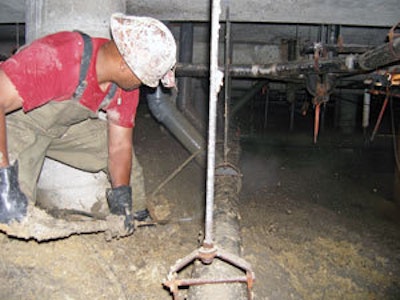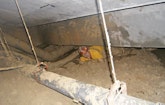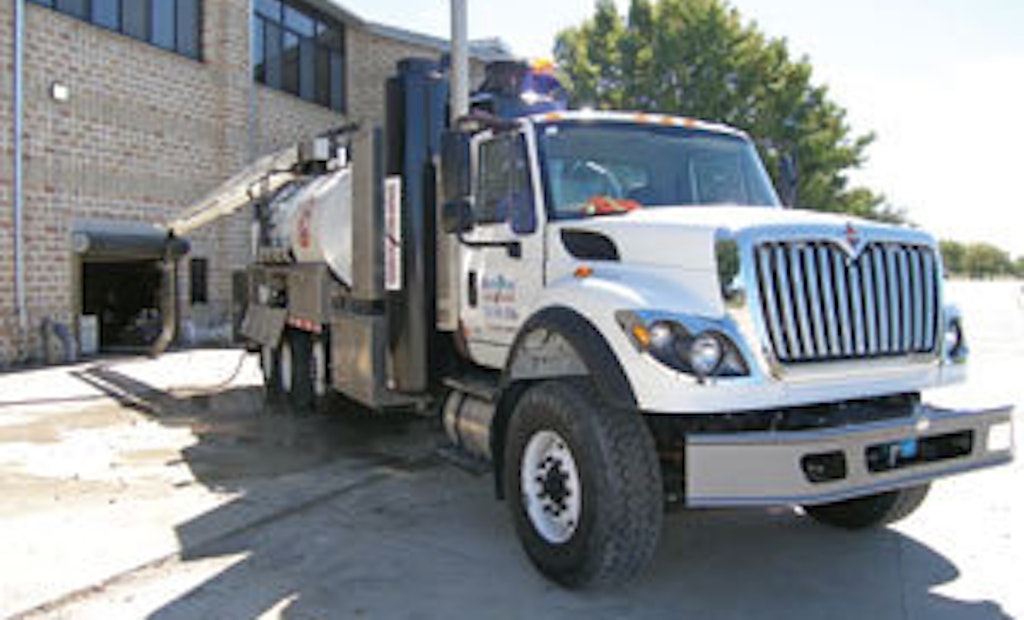Interested in Waterblasting?
Get Waterblasting articles, news and videos right in your inbox! Sign up now.
Waterblasting + Get AlertsFlooding frequently carried soil into the crawl space beneath the Palo Alto College natatorium in San Antonio, Texas. Seasonal swelling and shifting packed the soil ever tighter against the plumbing until the pressure cracked an 18-inch PVC drainline for an Olympic-size swimming pool and short course warm-up pool.
The force of 1.2 million gallons of water racing through the crack snapped a fused pipe joint, creating an 18-inch-long opening. The torrent pushed pipes out of their steel rod hangers, bent them in half, and moved stored equipment. Swimmers training in the Olympic pool felt the water drain.
Alpha Building Corp., a construction contractor, was on site and responded to the emergency. Project manager Mike Woodlee called Richard Young of Hydro Spy in Houston, a leader in hydroexcavation. “He told us to bring our two machines right away,” says Young. “The swimmers were preparing for an Olympic event, and the college couldn’t repair the pipe until we removed the soil.”
Young and partner Jose Santos had been on some of the toughest jobs imaginable, but nothing prepared them for this challenge. They spent 10 days on their stomachs swimming in mud under the pool, overcoming threats of avalanches and poisonous snakes. Their efforts enabled a plumbing contractor to repair the broken pipe.
Worse than expected
The natatorium had concrete trenches that channeled runoff to the stormwater system, but the volume often overwhelmed the catch basins. Excess flowed through ground-level service windows and air vents, depositing soil from an eroding hill in the 3-foot-square crawl space under the pool. College engineers knew of the problem, but didn’t know how to resolve it.
The pool had a drainpipe running lengthwise on either side and multiple 8- to 18-inch feed and recirculation lines crisscrossing east to west. Massive concrete beams and pilings supported the pool, turning the crawl space into an obstacle course.
“The engineers told us to hydroexcavate the soil at the corners of the pool to help the drainpipes settle back into the hangers,” says Young. “We could see the ends of the pipes because they extended beyond the pool into what became our staging area.”
The men parked an HV-56 HydroVac unit from GapVax and a Vactor HXX hydroexcavator from Jack Doheny Rentals near a maintenance shop entrance with an overhead garage door. They ran 150 feet of hoses through the shop and a window to reach the work area. Another man operated the trucks, while a fourth served as entry supervisor for a confined-space environment. They communicated with walkie-talkies.
After Young and Santos established and lit the staging area, they put on waders, yellow rain suits, steel-toe rubber boots, PVC gloves, hardhats and safety glasses. Using diamond-tipped and zero-degree hard-hitting nozzles at 11 gpm/2,900 psi, they cleaned one corner, but quickly realized the plan was not going to work.
“Soil extended as far back as we could see,” says Young. “The drainpipe was knocked out of the hangers and completely buried. No repairs were going to happen until we removed the restrictive soil, and that meant working from section to section as defined by the beams and pillars.”
Watch where you go
The soil was packed to within 8 to 12 inches of the pool bottom. Young and Santos blasted wider entrances under the 10 swimming lanes, then advanced one lane at a time on their bellies.
“We crawled along like bugs, using our toes and elbows to worm our way underneath the concrete floor while dragging the hoses,” says Young. OSHA standards did not require them to wear harnesses. The natural ventilation drew in hot, humid air.
The men never knew how fast they would advance. “One moment we were in a clay layer with some gravel that jetted nicely; the next, we were in gravelly morrow that was as hard as concrete and took some pressure to break up,” says Santos. “We worked 14-hour days to clean the length of one lane.”
After the first day, the GapVax truck was needed at another project. The Vactor unit remained, off-loading on site next to the soccer field. The only illumination under the pool were the lamps on the men’s hardhats.
“After we vacuumed under the next beam and crawled into the little opening beyond, we sat for three to five minutes until our eyes adjusted,” says Young. “We were in a pitch black abyss, and movement enhanced our disorientation.” They also worried about encountering vipers. “The building had numerous vents through which snakes could crawl at night and drop down to join us,” says Young. “We were always on the lookout for them, but never met one.”
As Young and Santos worked east, the plan was to relocate the hydroexcavator to that side of the building and excavate an entry point under the wall. But the engineers looked at the horrendous erosion and feared that the excavation would cause the pressure of the soil on the other side to trigger a collapse or landslide.
Temporary patch
The engineers had asked Young and Santos to remove soil along the east wall and re-establish the grade. As they cleaned, the engineers saw that the swimming pool had acted like shoring, preventing the steep incline of soil against the wall from shifting.
“They stopped us because they feared we’d vacuum too much soil and die in the resulting avalanche,” says Young. “Our focus shifted to removing just enough soil for the plumbing contractor to repair the hangers, re-hang the pipes, and replace the broken section.” Hydro Spy removed 3,700 tons of debris, and the Olympic hopefuls returned to training in the pool.








